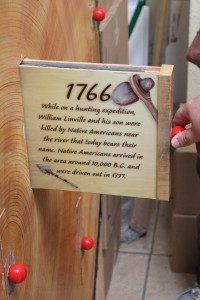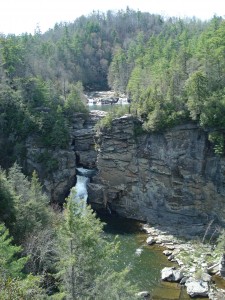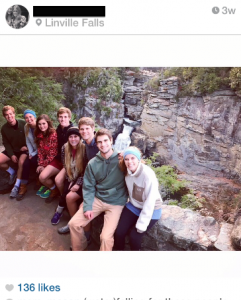Just off of the Blue Ridge Parkway, the always popular Linville Falls park has a 440-acre recreation area, mainly comprised of several hiking trails, the campgrounds and the Visitor Center. [1] The Linville Falls Visitor Center, located at milepost 317.8, hosts 350,000 visitors annually, though this number does not include visitors to the site to hike or camp that do not enter the doors of the center. [2] Connected to the Visitor Center are public restrooms, and the two facilities are joined by a roof that forms an inviting archway to the main trail, which begins on a bridge over the Linville River. Just outside the Visitor Center, before reaching the parking area, there is a campground with 50 tent and 20 RV sites adjacent to the banks of the river. This campground was established in the 1960s and, according to the National Park Service website, it is the Parkway’s most popular campground and the only site on the Parkway that has been developed for group camping. Linville Falls itself is 90 feet tall in total, though it cascades from multiple levels. Linville Falls was once much larger than it is today, cascading a total of 160 feet, but a major flood sometime between 1895 and 1906 carved through the stone, rerouting the river to become the smaller falls that it is today. [3] It can be viewed from several overlooks along two trails that lead from the Linville Falls Visitor Center, including Erwin’s View and Chimney View. The 0.8-mile Erwin’s View Trail also leads to an overlook offering a panoramic view of the connecting Linville Gorge, which is a 12,000-acre protected wilderness area maintained by the US Forest Service.
Timeline
The Visitor Center features an interactive display of a tree ring turned on its side, with sliding panels that provide prominent dates that the National Park Service highlights as key milestones. Some of these milestones include:

Jones, J. Visitor Center Interactive Display, 1766 Panel. 2014.
- 1766: William Linville and his son are killed by Native Americans during a long hunting expedition along the Linville River. The river is named after William Linville, an in-law to Daniel Boone.
- 1864: Confederate government sends two men to build a dam on the river, but they are captured in a raid before completing it.
- 1895-1906: Massive flood carves away stone, causing the falls to reduce in size by nearly half.
- 1916: Record-breaking flood in the area, destroying most of the area’s railroads.
- 1951: Owners of the land, the Hossfeld Heirs, sell to John D. Rockefeller, Jr. for $100,000. [4]

Images of some of the sliding panels inside the Linville Falls Visitor Center.
Jones, J. Visitor Center Interactive Display, 1952 Panel. 2014.
- 1952: Falls land is donated to the National Park Service by John D. Rockefeller, Jr.
- 1964: Congress passes the Wilderness Act and Linville Gorge becomes one of only two areas in the eastern US to be designated “wilderness.”
- 1984: NPS opens Linville Falls Visitor Center at its current location, off of the Blue Ridge Parkway.
- 2002: Invasion by Hemlock Wooly Adelgid, which today continues to cause devastation on old growth Hemlock trees. Since the invasion, the park has lost its oldest known tree, which was over 500 years old.
- 2004: More massive flooding from Hurricanes Francis and Ivan causes significant damage to the Visitor Center. They temporarily ran the Visitor Center out of a family general store nearby. Before the center’s opening in 1984, this same store served as an informal information center for the park.
The Romantic History of the Falls
“With a last day and night on the river, sleeping on a great flat rock on cucumber tree leaves to the tune of broiled trout and the gentle lullaby of the passing stream and with a luxurious camp-fire all night before us, we bade a reluctant au revoir to Linville Falls. We might have lingered on there for weeks without seeing half of its attractions.” –Frank W. Bicknell, 1912. [5]Linville Falls has historically been a place of serenity and natural beauty. Today, park guests take the time to visit in order to simply enjoy the outdoors through hiking, camping, and general awe of the mountain and falls landscape. Even before the National Park Service operated and promoted the land as a recreation area, visitors from all around enjoyed the views the land offers. The hiking trails that are maintained today were built sometime around 1966, but are relics of the informal trails that existed long before the NPS was even involved in the area. [6]
A view of the hiking trail in 1978. Westveer, C.E. Hiking trail to Linville Falls. Photograph, August 1978. Driving Through Time
A view of Erwin’s View Trail in 1976, while under repair. Westveer, C.E. Repairs on Erwin’s View Trail. Photograph, 14 October 1976. Driving Through Time.
In the shift from the privately-owned land to the public recreation area, any ideas of homesteading or working the land were lost over time. While turn of the century residents like Frank Bicknell or the Hossfeld family fished the upper falls for their evening dinner, hunted for deer or bear for sport, and churned apple butter on their scenic rural land, their time at Linville Falls marks the transition of activities like these toward vacation leisure rather than commonplace or methods of survival.
Automobiles and trailers at the Linville Falls camping area, 1978. Westveer, C.E. Photograph, August 1978. Driving Through Time.
Furthermore, an interview with Bob Hewat confirms the shift from privately owned to a public area of recreation. He notes that, “Linville Falls was nothing. The picnic area, yes, it was here. The campground and the Visitor Center were in the making. And the Visitor Center didn’t open until sometime in ’84.” [7] He recalls this to emphasize the fact that Linville Falls used to be a working community before the National Park Service began to build amenities and attractions in order to reel in visitors. Many of these improvements did not begin until around 1961, when the NPS received $586,956 toward road, bridges and other work at Linville Falls.
Cars and trailers parked at campground at Linville Falls, 1970s. Westveer, C.E. Photograph, 1970s. Driving Through Time.
Additionally, Hewat recounts several stories about people falling into the water at the Falls and the number of times the Rescue Squad had to make rescues in the water. He noted that, “[the Rescue Squad] don’t go down just to be going like, to have an excuse to be on the Parkway, they go down to work. They’re sincere in that job.”[8] The nature of the Squad testifies to the fact that Linville was now a professional establishment that adhered to liability concerns and the concerns of its visitors. Linville was no longer a small community but rather a thriving recreational area that began to take responsibility for its amenities and its actions.
Parking area for tourists, 1978. Westveer, C.E. Photograph, August 1978. Driving Through Time.
Ranger leading campers in a talk and search for articles, 1978. Westveer, C.E. Photograph, 1 August 1978. Driving Through Time.
Visitor Experience
Visitors have traveled to Linville Falls for many years, drawn by its natural beauty and for the rock vistas that allow for spectacular views of the surrounding mountains. Long before the dream of the Blue Ridge Parkway, private visitors were using what would later become to Linville Falls Recreation Area for a recreational purpose. Today, hikers, campers, backpackers, and rock climbers are all active in the area, and the NPS has expanded their visitor base far beyond just local tourists into both national and international visitors. [9] The Erwins Trail, a 0.8 mile trail that leads from the Linville Falls Visitor Center, is one of the most popular trails at the site. Amenities at the site include picnic grounds, around 50 campsites, the Visitor Center, and restrooms. Visitors may enjoy self-guided hikes and trout fishing among many recreational opportunities. The Linville Falls Restaurant, a feature of the area before the creation of the Recreation Area, continues to serve the public in its current incarnation as Famous Louise’s Rock House Restaurant.
Visitors have been able to share their experiences through the progress of social media. Their experiences have been viewed by people all over the internet, which aids in further attraction to the Falls. From the social media stories that have been explored, the people who visit Linville Falls display sheer happiness during their visit. Linville Falls is not a place of the past, but rather a continually growing attraction for the young and old, alike. People visit year round to explore the beauty and all that the Falls have to offer. Find anyone who has visited and they will tell you of the magnificent Falls as well as the surrounding opportunity for fun, nature, and education. Linville Falls and the NPS have crafted the recreational sites in such a way as to appeal to all people from across the United States and beyond.
Launch Linville Falls Digital Exhibit



